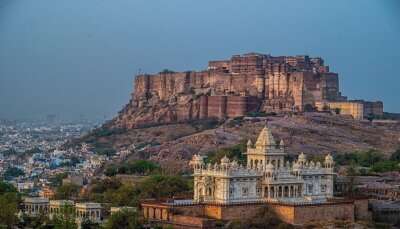Visit The Rajasthani Town Of Baori For A Unique Escapade In 2026
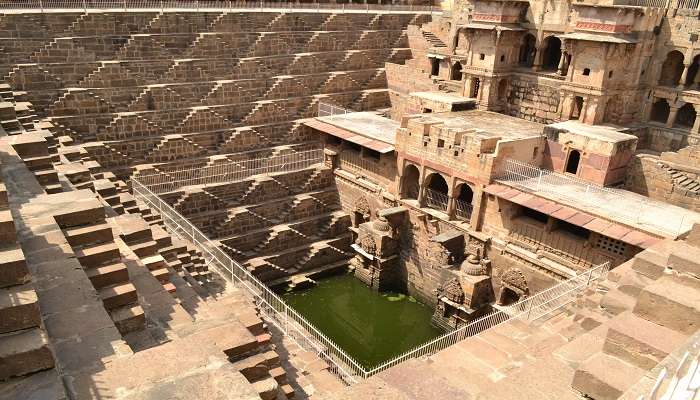
Baori, or step-wells, are an integral part of Indian architecture but go majorly unnoticed due to their lesser presence and preference among tourists. Stepwells were constructed across many parts of India, with the highest concentration in the arid regions of Rajasthan and Gujarat. They served as important community hubs for providing water, shelter, and a place for social and religious gatherings. Read ahead to learn more about Baori and uncover this place’s true potential for you when you embark on a journey to Rajasthan. We’ll be exploring the largest stepwell in Rajasthan, Chand Baori, constructed approximately a thousand years ago in Abhaneri Village.
History Of Baori
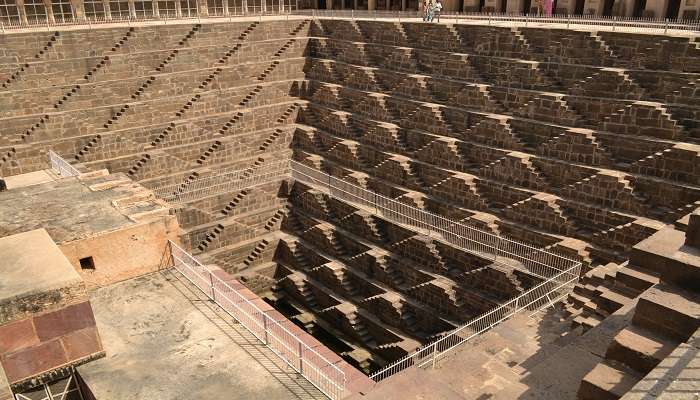
Chand Baori is one of the oldest and largest stepwells in India. It was built in the 8th or the 9th century by Raja Chanda of the Nikumbh dynasty in the village of Abhaneri in Rajasthan. Since Rajasthan is an extremely arid region, these Stepwells originated during periods of drought to ensure access to water and played a significant role in advancing underground architecture in India. The earliest archaeological evidence of these step-wells is found at Dholavira, where the site also has water tanks or reservoirs with flights of steps. Ashokan inscriptions mention the construction of step-wells along major Indian roads at a distance of every 30 to 35 km for travellers’ convenience. The Harshat Mata Temple, which was dedicated to the goddess of joy, was a major pilgrimage site and formed a beautiful complex together with the well.
Must Read: Haunted Places In Rajasthan
Harshat Mata Temple
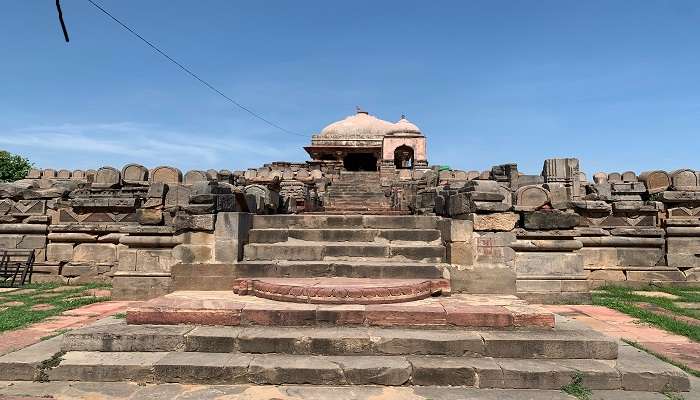
The significant temple for Hindu pilgrims dedicated to the goddess of happiness and joy or “harshat” is known as the Harshat Mata Temple and is located in the Abhaneri village of Rajasthan. The name portrays the spread of goodness and positivity by the deity in this region. It is believed that the temple was constructed shortly after the construction of Chand Baori Stepwell during the early 9th century. it was originally constructed in the panchayatana style, meaning the main shrine was surrounded by four smaller shrines. Over centuries, the temple suffered a lot of architectural damage, especially when Islamic rulers like Mahmud Ghazni attacked the town. This led to the loss of architectural beauty, and today, the remaining sculptures and ruins at this place are what is left of the temple. You will be able to spot a variety of themes in these remains, such as dancing, music, and other romantic encounters that depict the artistic excellence of that period.
Places To Visit Near Baori
There are several interesting places around Baori that offer a blend of historical, cultural, and dining experiences. Visitors must explore these notable attractions in the vicinity.
1. Sisodia Rani Bagh
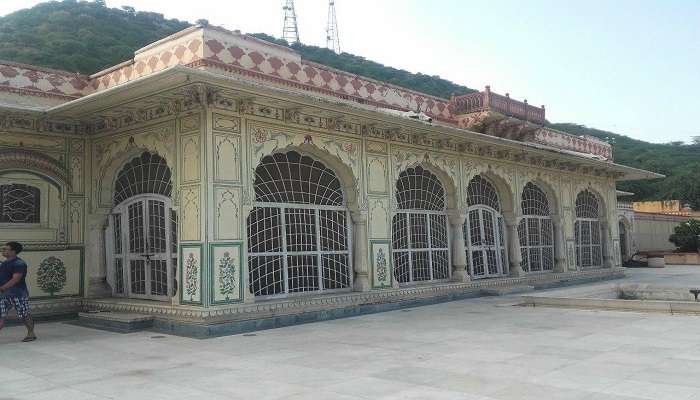
The Sisodia Rani Bagh is a palace garden located about 6 kilometres from Jaipur, which was built in 1728 by Maharaja Sawai Jai Singh II as a gift for his second wife, the Princess of Udaipur who belonged to the Sisodia Rajput clan. For Indian visitors, an entrance fee of 50 INR is charged, and for foreign tourists, 200 INR is charged at the entry gate. The garden remains open from 8 AM to 5 PM. At the top of this palace, the terrace gardens feature beautiful paintings and murals depicting Lord Krishna and his beloved Radha. Monsoon and winter are considered the best times to visit because you will come across pretty flowers in full bloom. In addition to the palace and gardens, the site also features a central shrine and natural spring and is a popular destination for photography, history, and nature enthusiasts.
Location: Agra Rd, Ghat Ki Guni, Jaipur, Rajasthan
Entrance Fee: INR 50 for Indian adults and INR 20 for students; INR 200 for foreign tourists
Suggested Read: Sawariya Seth Mandir
2. City Palace Jaipur
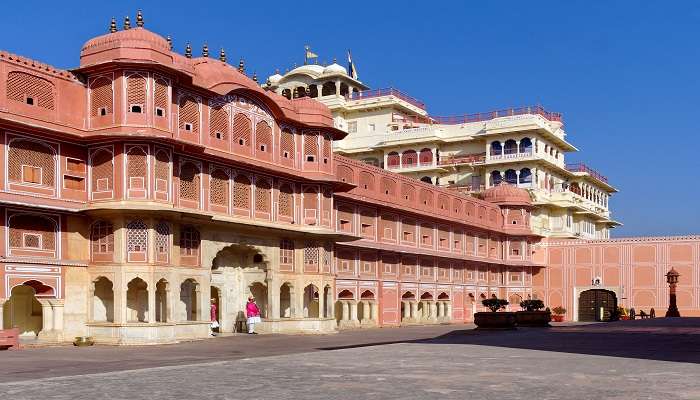
The City Palace of Jaipur is a residence for the royal family and is the former administrative headquarters of rulers of the Jaipur State. This site’s construction started soon after Jaipur’s establishment under the reign of Maharaja Sawai Jai Singh II, who moved his court to Jaipur from Amber in 1727. The palace complex comprises several buildings with various courtyards, galleries, restaurants and offices of the Museum Trust. Currently, it houses the Museum of Maharaja Sawai Man Singh II and continues to be the home of the Jaipur royal family. The palace is very close to the astronomical observatory, so you can visit it on the trip on the same day. The City Palace is a must-visit for any tourist to Jaipur as it is one of the places that hold immense importance in the history of India. It is recommended that you avoid visiting during summer afternoons as it can get extremely hot to walk outdoors without any shade in the large open sections of the palace.
Location: Gangori Bazaar, J.D.A. Market, Pink City, Jaipur, Rajasthan
Entrance Fee: INR 200 for Indian adults and INR 100 for children
3. Nahargarh Fort
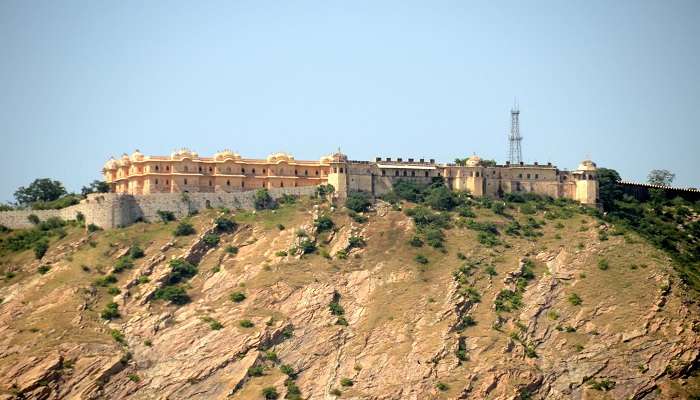
Nahargarh Fort is another impressive and popular tourist attraction in Jaipur, built by Maharaja Sawai Jai Singh II in 1734. Initially, the fort was named as Sudarshangarh, but due to the presence of a large number of tigers here, it was soon renamed to Nahargarh after the prince who last lived at this fort. The main highlight of this fort is Madhavendra Bhawan, a two-story palace built by Sawai Madho Singh II during the late 19th century. It features nine identical lavish suites for the king’s nine queens. These suites have a secret corridor leading to the king’s chambers. It is believed that the fort is now haunted and is home to the spirit of Prince Nahar Singh Bhomia, whose life was cut short by political intrigue. Later, a temple was also built here to appease the spirit, but the site still remains one of the most scary places in the world.
Location: Krishna Nagar, Brahampuri, Jaipur, Rajasthan
Entrance Fee: INR 50 for Indian nationals and INR 20 for Indian students
Further Read: Things To Do in Rajasthan
Now that you have a list of things to remember for your next vacation to Baori, make sure you plan your trip to Rajasthan to these fabulous spots for the experience of a lifetime. Don’t miss out on these opportunities, and book your tickets now!
For our editorial codes of conduct and copyright disclaimer, please click here.
Cover Image Credit: Chetan for Wikimedia Commons
Frequently Asked Questions About Baori
Which is the largest Baori in Rajasthan?
The largest and most famous baori in Rajasthan is Chand Baori which is located in the village of Abhaneri. This remarkable stepwell was constructed in the 9th century during the reign of King Chanda and features 3,500 narrow steps arranged in a precise geometric pattern and descends approximately 20 meters to the water level.
Why is Abhaneri famous?
Abhaneri has become a quite popular tourist destination due to several factors. The primary and most obvious one being, Chand Baori. Near the stepwell, lies the great temple of Harshat Mata which is a yet another famous destination for Hindu pilgrims. Various cultural festivals organized here and the immense historical significance also attracts a large number of tourists.
How to reach Chand Baori in Abhaneri?
The most convenient way is to hire a taxi or rent a car from Jaipur, which is approximately 95 km away. The drive typically takes about 1.5 to 2 hours. Since there are no direct buses available, you can Take a bus to Sikandra and then hire a jeep or taxi to Abhaneri or Take a bus to Gular and then walk for about an hour to reach Abhaneri.
What is the timing and entrance fee to visit Chand Baori?
Chand Baori is open from 8:00 AM to 6:00 PM. There is no entry fee for visiting the stepwell.
Which time of the year is the best to visit Chand Baori?
The best times to visit Chand Baori in Abhaneri are during the winter months, specifically from October to March. This period offers cooler and more pleasant weather, making it ideal for exploring the stepwell and the surrounding area
People Also Read:
Romantic Things To Do In Jodhpur Places To Visit In Jodhpur Places To Visit In Rajasthan

With a passion for exploring and travelling to the roads long forgotten, experience the world through enthralling stories and adventures. Join me as I share my experiences at some of the world’s most popular tourist destinations and quench that pestering curiosity with something exciting!





